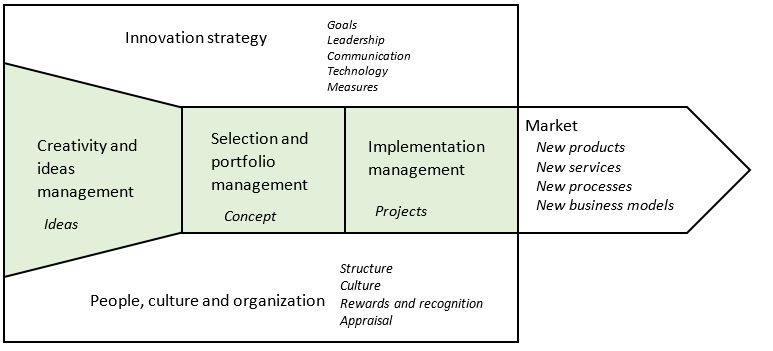
Types of innovation
 TYPES OF INNOVATION
TYPES OF INNOVATION
There are many ways to classify different types of innovation.
![]() Innovation by outcomes
Innovation by outcomes
Most commonly classification of innovation is it by its outcomes to product, process, marketing and organizational innovation (Foss & Saebi, 2017; OECD, 2018; Tidd & Bessant, 2018):
- Product innovation: new or improved products or services that significantly differ from the previous offerings in the markets.
- Process innovation: significant changes in how products and services are created and delivered to customers.
- Marketing innovations: changes in designs, packaging, promotion, distribution and pricing of product and services.
- Organizational innovation: novel changes in business practices, organization of activities and relationships between external and internal stakeholders.
Some authors developed more detailed lists (table 1).
Table 1. 10 types of innovations (Keeley, Walters, Pikkel, & Quinn, 2018)
| Product |
|
| Process |
|
| Marketing |
|
| Organizational |
|
![]() Degree of radicalness (Ettlie & Rubenstein, 1987; Garcia & Calantone, 2002; Dodgson, Gann, & Phillips, 2013; Goffin & Mitchell, 2016; Tidd & Bessant, 2018)
Degree of radicalness (Ettlie & Rubenstein, 1987; Garcia & Calantone, 2002; Dodgson, Gann, & Phillips, 2013; Goffin & Mitchell, 2016; Tidd & Bessant, 2018)
- Radical innovations/ discontinuous innovations: new, revolutionary innovations that are radical departure from previous practices or products. Radical innovations create discontinuities in both macro and micro level, generate new types of technologies and new types of demands. Radical innovations create products, processes for markets that do not yet exist and seed whole new industries and disrupt the existing ones.
- Incremental innovations/continuous innovations: gradual refinement or imitations of existing products, processes, organizations in existing markets. These are low risk and usually low-cost day-to-day refinements. The goal is to increase the share in existing markets.
Research literature and policies are often biased towards radical innovations, while in reality they tend to be rare. Majority of innovations are incremental innovations.
![]() Architectural or modular (Salter & Alexy, 2013)
Architectural or modular (Salter & Alexy, 2013)
- Architectural innovations- significant new ways of bringing elements or systems together.
- Modular innovation – changes in a single component, does not affect other components.
![]() Openness of the innovation process (Kerzner, 2019)
Openness of the innovation process (Kerzner, 2019)
- Closed innovation: an organization controls who cycle from generation of ideas, production, marketing, distribution, financing, supporting.
- Open innovation: organization uses external resources and actors and collaboration for ideas, research, development, production, distribution activities.
Innovation activities refer to “all developmental, financial and commercial activities undertaken by a firm that are intended to result in an innovation for the firm” (OECD, 2018, lk 20). Innovation management refers to systematic planning, leading, organization, control and of innovation activities in an organization.
Innovation management concerns the how organizations (Dodgson, Gann, & Phillips, 2013):
- Search innovation opportunities internally and externally.
- Evaluate and decide which innovations to pursue.
- Deploy and develop their resources.
- Capture value from their innovations, incl. creation of competitive advantages, intellectual property.
- Build their capabilities for and through the innovation activities.
- Review their innovation performance and learn from the process.
The core set of activities of innovation process are the search for ideas, selection of idea and implementation of innovation that includes acquiring the resources, executing the innovation, launching the innovation, innovation adoption and diffusion, learning and modifications (Tidd & Bessant, 2018).
Many different models for explaining innovation process in organizations have been developed. Typically, those address the core set of activities – idea generation, selection and implementation. The process starts with a funnel of ideas for new products, services, processes and models. Some ideas are filtered out and best ideas proceed to the concept development (Goffin & Mitchell, 2016). More detailed assessments are made, incl. market, financial analysis and best concepts are selected for implementation, while others are rejected or recycled back to idea phase. During the implementation phase new product, services, processes are developed and tested, but some will be abandoned and will not make into the market phase (Goffin & Mitchell, 2016).
 Figure 2. The Innovation Pentathlon framework (adopted from (Goffin & Pfeiffer, 1999; Goffin & Mitchell, 2016)
Figure 2. The Innovation Pentathlon framework (adopted from (Goffin & Pfeiffer, 1999; Goffin & Mitchell, 2016)
![]() Innovation Pentathlon Framework offers a simplified model comprising of five main elements of innovation management: creativity and ideas management, selection and portfolio management, implementation management, innovation strategy and human resource management (Goffin & Pfeiffer, 1999; Goffin & Mitchell, 2016). Innovation strategy includes determining and communicating what are the ongoing market trends, aims and resources, capabilities of the organization and how those relate to innovation activities. Underlying each activity are the human resource management issues such as organizational structure, culture, personnel policies which determine how the innovation activities are carried out.
Innovation Pentathlon Framework offers a simplified model comprising of five main elements of innovation management: creativity and ideas management, selection and portfolio management, implementation management, innovation strategy and human resource management (Goffin & Pfeiffer, 1999; Goffin & Mitchell, 2016). Innovation strategy includes determining and communicating what are the ongoing market trends, aims and resources, capabilities of the organization and how those relate to innovation activities. Underlying each activity are the human resource management issues such as organizational structure, culture, personnel policies which determine how the innovation activities are carried out.
The innovation process is affected by the interactions between the variety of external environmental factors and internal resources, capacities and practices.
The innovations processes in an organization can be (Dodgson, Gann, & Phillips, 2013):
- Research and technology led: science and research stimulate innovation in the organization.
- Market led: study of changes in market demand and discovery of new opportunities triggers innovation process.
- Internal coupling: an organization finds new combinations of different internal capacities and collaboration.
- External collaboration: organizations connect with external partners to search and create innovations.
- Strategic integration: organization combines internal and external resources with their strategic objectives.
- Preparation for future disruptions: anticipation for changing business model and disruptions in technologies, markets, regulations facilitate innovation activities.
- What do you think have been the main triggers or drivers for innovation in the last decades related to the research field of your doctoral studies?
- In the field of your doctoral studies, what kind of radical innovations are anticipated for the next decades?
- Think of 3 innovation related to your field of studies. What type of innovations those have been? How radical?
- Can you name any inventions in your field that did not reach implementation phase or have yet not reached implementation?


